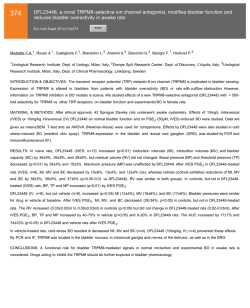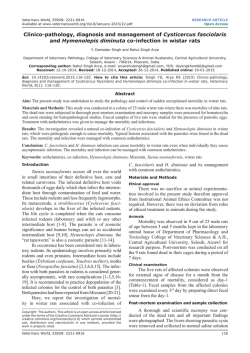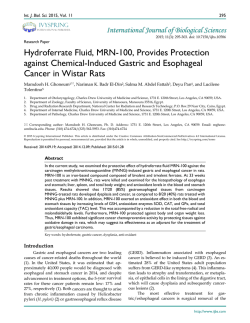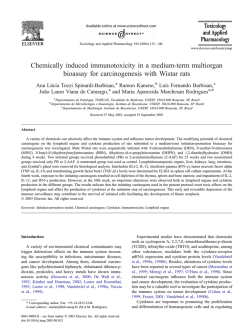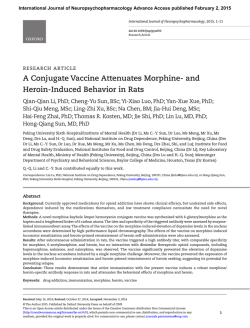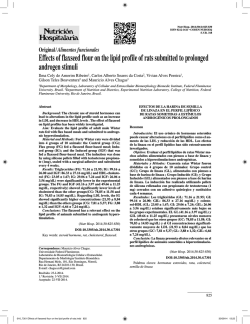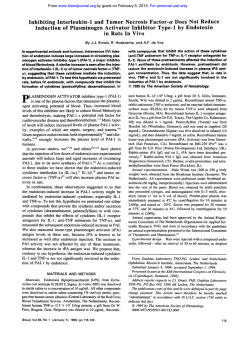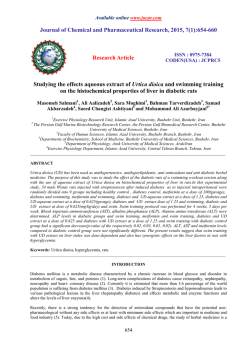
The effect of anabolic steroid nandrolonedecanoate on exercise
Available online www.jocpr.com Journal of Chemical and Pharmaceutical Research, 2015, 7(1):671-677 Research Article ISSN : 0975-7384 CODEN(USA) : JCPRC5 The effect of anabolic steroid nandrolone decanoate on exercise-induced hypoalgesia: Role of opioid peptides Khalil Pourkhalilia, Mehdi Mohebbib, Mahnaz Kesmatib, G. Hossein Mohebbic, Samad Akbarzadehd and Zahra Akbaria* a Department of Physiology, Faculty of Medicine, Bushehr University of Medical Sciences, Iran b Department of Biology, Faculty of Sciences, Shahid Chamran University, Ahvaz, Iran c The Persian Gulf Marine Biotechnology Research Center, the Persian Gulf Biomedical Research Center, Bushehr University of Medical Sciences, Bushehr, Iran d Department of Biochemistry, Faculty of Medicine, Bushehr University of Medical Sciences, Iran _____________________________________________________________________________________________ ABSTRACT A number of athletes abuse anabolic steroids to improve muscle performance. It has been shown that supratherapeutic doses of these substances can effect on opioidergic system. It is well known that aerobic exercise has hypoalgesic effects, which proposed to be related to activation of opioidergic system. In this study, the chronic effects of nandrolone decanoate on nociception, β-endorphin and met-enkephalin levels in exercised rats were evaluated. For our aims, both Sedentary (S) and trained (T) male rats received daily injections of nandrolone (15 mg/kg, 5 times/week) or vehicle. After two weeks, nociceptive threshold was estimated by tail flick test, and Circulating levels of β-endorphin and met-enkephalin were determined using ELISA method. Results showed that two weeks of swimming exercise training, were significantly increased nociceptive threshold and serum opioid peptides levels. Administration of nandrolone decanoate was significantly decreased nociceptive threshold and opioid peptides levels in trained group; despite its decline, the effect of nandrolone decanoate in sedentary group was not statistically significant. In conclusion, these findings revealed that two weeks administration of nandrolone decanoate can reduce the plasma opioid peptides level as well as exercise induced hypoalgesia in trained rats. Key words: Nandrolone decanoate, Nociception, Β-endorphin, Met-enkephalin, Exercise- induced hypoalgesia. _____________________________________________________________________________________________ INTRODUCTION It is well known that exercise has beneficial psycho physiological effects, including enhanced attention, memory capacity and elevation of mood [1]. Several investigations assess the effects of physical exercise on pain modulating system. Although, the different results in various experimental settings, the elevated pain thresholds were demonstrated in athletes as compared with untrained individuals [2, 3,4]. While the lack of defined mechanisms responsible for the hypo nociceptive effect of exercise, it has been reported that the opioidergic mechanisms, play an important role [5]. Several animal studies showed that pain threshold and plasma level of opioid peptides increased concomitantly following exercise. Naloxone reversal confirmed the pivotal role of opioids in the condition [6]. It has been recently reported in human studies that the brain opioids levels were increased following the exercise [7]. Anabolic androgenic steroids (AAS) are the synthetic compounds with most commonly clinical uses to treat androgen deficiency [8]. In recent years, the non-medical abuse of these steroids by young athletes for promoting the 671 Zahra Akbari et al J. Chem. Pharm. Res., 2015, 7(1): 671-677 ______________________________________________________________________________ athletic performance has dramatically grown [9,10]. They consume the AAS, to 100 times higher than the therapeutic doses. Keeping in mind that androgen receptors, widely distributed in the organ tissues, various physical and psychological side effects are expected with chronic use of high doses of AAS [11]. Topical findings, suggest that the effect of AAS on neurotransmitter modulating behavioral response, may underlie unwanted adverse effects [12]. In addition, the animal study results were revealed the AAS interaction of dopaminergic, serotoninergic and opioidergic brain systems [13, 14]. Endogenous opioid peptides via their widespread receptors involved in several physiological processes including pain modulation. Due to the effect of AAS on opioidergic system, it was proposed that anabolic steroids, expected to play a role in pain processing. However, some previous studies regarding androgens effect on nociception are inconsistent. The opioid dependent analgesic effect of endogenous androgens was demonstrated by some authors; however, others found no effect on opioid antinociception [15, 16]. Moreover, it was perceived that following castration, the analgesic effect of opioids was increased [17]. In agreement with this finding, it has been shown that the AAS administration can decrease analgesic effect of opioids [18, 19]. Also, exercise can mainly induce antinociception through the opioid peptides. Alternatively, chronic treatment with nandrolone can effect on opioidergic system. It was no previous study around the nandrolone effect on pain perception in exercise induced analgesia. Therefore, in current work, the chronic effects of nandrolone decanoate on nociception, β-endorphin and met-enkephalin levels in exercised rats were evaluated. For these objectives, the tail flick latency of exercised rats after two weeks nandrolone administration and swimming training, as well as plasma β-endorphin and met-enkephalin levels as mediators of pain modulating system were evaluated. EXPERIMENTAL SECTION Animals Adult male Sprauge-Dawley rats weighing 220 to 250 grams at the beginning of experiment were used. The rats were group housed in the controlled-temperature (22±2°C) rooms under a 12h light/ 12h dark cycle. The animals had free access to food and water. Animals were acclimatized to the laboratory environment for at least one week before testing. All animal work was approved in accordance with the National Ethical Guidelines for Animal Research in Iran (2005), which was approved by the Animal Care and Use Committee of Bushehr University of Medical Sciences, Iran. Animals were randomly assigned into two main groups of sedentary (S) and trained (T) rats. In sedentary and trained groups, animals randomly received an intramuscular daily injection of either the AAS nandrolone decanoate (Nan), 15 mg/kg, for 5 times a week or an equal volume of Arachis oil as vehicle (VCL) for 2 weeks. The dose of nandrolone was chosen based on the previous studies reported an effect on opioidergic system [18]. Swimming exercise protocol A program of swimming exercise training was adapted according to Shokri and colleagues methods [20]. Exercise performed by swimming in a pool (length 100 cm, width 100 cm, depth 50 cm) containing tap water maintained at 34–36 °C. Swimming exercise protocol included one week acclimatization followed by 2 weeks exercise training. At the start, the animals exercised in the pool for 10 min. In the subsequent days, the swimming time was extended 10 min each day until 60 min per day at the end of first week. Subsequently, the animals exercised 60 min per day for 5 days in a week for subsequent 2 weeks. To minimize possible confounding effect of stress-induced analgesia, behavioral tail flick testing was done twenty four hours after the last bout of exercise. Behavioral test Nociceptive threshold in rats was performed using tail flick test. Before test session, animals were gently handled and exposed to the restrainer for a few minutes and then placed on the platform of the tail flick apparatus (HSE 812, Germany). A beam of light with adjusted intensity focused on the rat tail; besides when the animals flicked its tails, the light turned off. The response latency for each animal was the mean of three constitutive measurements, taken at 3-min intervals. In order to prevent possible tissue damage, cut-off time for each test was set to 10 seconds. To obtain baseline nociceptive threshold, the tail flick test was done for each animal, before any treatment. After two weeks treatment with nandrolone or mineral oil, the pain threshold was also determined in all experimental groups. 672 Zahra Akbari et al J. Chem. Pharm. Res., 2015, 7(1): 671-677 ______________________________________________________________________________ Determination of plasma opioids by ELISA assay After behavioral test, the blood samples were collected from anesthetized rats (by isoflurane) by heparinized syringes via cardiac puncture. After separation of plasma by centrifugation (5000 × g for 5 min at 4°C), they stored at -80°C until analysis. The plasma opioids level was measured by ELISA kit (Shanghai Crystal Day Biotech Co., China) according to the protocol provided by the manufacturer. Statistical analysis The data obtained from the Study were analyzed by independent-samples T Test, using SPSS 16 for Comparison of variables; Data were expressed as Means±SEM, and the P. value ˂0.05 was considered statistically significant. RESULTS AND DISCUSSION Body weight The effects of exercise training and nandrolone administration on body weight of the animals are represented in Table 1. Changes in each body weight (BW), throughout the experiment period calculated as percent increase from the initial value. As shown in table 1, the exercise training, significantly reduced BW in vehicle trained (VCL-T) rats in compared with vehicle sedentary (VCL-S) rats (P<0.01). Likewise treatment of rats with nandrolone for 2 weeks also caused a remarkable reduction in BW gain of sedentary (Nan-S) and trained (Nan-T) rats, in compared with the VCL-S group (P<0.01). Table 1: Body weight and the ratio of third week to first week body weight (BW3/BW1) of the animals Body weight (g) BW3/BW1(% of increase) N Week1 Week3 יִ VCL-S 177 212 20 10 ײַ Nan-S 207 214 3* 10 † * VCL-T 224 226 1 10 ‡Nan-T 224 217 -3* 10 יִ VCL-S: vehicle sedentary group; ײַNan-S: nandrolone sedentary group; †VCL-T: vehicle trained group; ‡Nan-T: nandrolone trained group. * P < 0.01 vs. VCL-S. Groups Tail flick latency An initial assessment of nociceptive threshold before any treatment revealed no significant differences between groups (Fig. 1). Fig. 1: Basal tail flick latency of the sedentary and trained animals at the beginning of the experiment Data expressed as Mean±SEM. Solid bars represent vehicle group (VCL) and open bars represent nandrolone received group (Nan). Two weeks swimming exercise significantly increased tail flick latency in vehicle trained rats in compared with vehicle sedentary rats (P<0.05); it indicates that exercise itself increases the nociceptive threshold. Nandrolone abolished the exercise-induced increase in tail flick latency in trained rats (P<0.01). Moreover, it was decreased in sedentary rats, but not significant (Fig. 2). 673 Zahra Akbari et al J. Chem. Pharm. Res., 2015, 7(1): 671-677 ______________________________________________________________________________ ¤ * Fig. 2: Effect of two weeks nandrolone decanoate treatment on tail flick latency of the sedentary and trained animals Data expressed as Mean±SEM. Solid bars represent vehicle group (VCL) and open bars represent nandrolone received group (Nan). (¤): P<0.05 vs. vehicle sedentary group, * P<0.05 vs. vehicle trained group. Effects of swimming exercise and nandrolone on plasma opioids level In order to identify the possible mediators involved in the hyperalgesia induced by nandrolone administration, the plasma level of two opioid peptides, β-endorphin and met-enkephalin, were evaluated. The results showed that two weeks swimming exercise, increased the plasma level in both β-endorphin (114±5 vs. 98±5 ng/l, P<0.05) and metenkephalin (1567±39 vs. 1456±29 ng/l, P<0.05) in VCL-T rats, in compared with VCL-S group (Fig. 3). ¤ * Fig. 3: Effect of two weeks nandrolone decanoate treatment on serum level of β-endorphin Data expressed as Mean±SEM. Solid bars represent vehicle group (VCL) and open bars represent nandrolone received group (Nan). (¤): P<0.05 vs. VCL-S group; * P<0.01 vs. VCL-T group. Remarkably, the effects of nandrolone treatment on plasma opioids level in our study was in concordance with the tail flick behavioral response. According to (Fig. 4), two weeks nandrolone treatment, caused a significant reduction in plasma β-endorphin (84±4 vs. 114±5 ng/l, P<0.01) and met-enkephalin (1378±36 vs. 1567±39 ng/l, P<0.01) levels, in trained rats. 674 Zahra Akbari et al J. Chem. Pharm. Res., 2015, 7(1): 671-677 ______________________________________________________________________________ ¤ * * Fig. 4: Effect of two weeks nandrolone decanoate treatment on serum level of met-enkephalin Data expressed as mean±SEM. Solid bars represent vehicle group (Veh) and open bars represent nandrolone received group (Nan). (¤): P<0.05 vs. VCL-S group; * P<0.01 vs. VCL-T group. Major findings of the present study are that two weeks nandrolone administration decreases the plasma level of endogenous opioid peptides; β-endorphin and met-enkephalin in trained rats. Accordingly, pain threshold assessed by tail flick test also decreased following nandrolone treatment. We also showed that nandrolone treatment remarkably reduced body weight gain in sedentary and trained rats, indicating that the AAS treatment plan we used was sufficient in dosage and duration. Our results showed that chronic swimming exercise increased pain threshold in tail flick test. This result is in agreement with previous studies showing altered nociceptive threshold following physical exercise. A considerable number of studies in laboratory animals and also in humans have demonstrated that exercise is associated with decreased pain perception [21, 22]. However, the precise mechanisms underlying the hypo nociceptive effect of exercise remained to be clearly understood. Probably the most widely considered mechanism which explains exercise-induced hypoalgesia is the activation of the endogenous opioid system. It has been shown that exercise of sufficient intensity and duration results in the release of peripheral and central opioid peptides, which have been associated with changes in pain rating [23]. The results of present study are in line with previous human and animal studies showed the involvement of opioidergic system in the hypo nociceptive effect of exercise [24, 25]. However, it is important to note that plasma level of opioid peptides gives limited information about behavioral consequence [26]. Therefore behavioral assessment of pain perception also needed to verify central or peripheral effects of opioidergic mechanism. Interestingly, we found that changes in plasma opioids level were consistent with behavioral results; tail flick latency also increased in exercised rats. Endorphins are primarily synthesized within the hypothalamus, the anterior pituitary gland and spinal nerves. Furthermore, chromaffin cells of the adrenal medulla store opioid peptides in several mammalian species. Although direct influence of peripheral blood opioids on the brain is limited by blood–brain barrier, the fact that peripheral endogenous opioids are involved in the modulation of nociception and act on peripheral afferents and spinal neurons, suggests that opioid entry into the brain would not be required for an anti-nociceptive effect of opioids. In this regard, it has been revealed that the hypo nociceptive effects of extended swimming exercise were inhibited by the bilateral adrenalectomy in mice, indicating that endogenous opioids released by adrenal glands might contribute to the hypo nociceptive effect of exercise [27]. Therefore, we suggest that elevated releases of endogenous opioids met-enkephalin and β-endorphin are responsible for observed hypo nociceptive effect of extended swimming exercised in trained rats. Majority populations of AAS users are athletes and bodybuilders which abuse these substances in order to increase muscle mass and physical endurance [28]. However the desired effects of AAS are accompanied by various psychosomatic adverse effects. The findings of the present study showed that two weeks administration of nandrolone decanoate decreased pain threshold in trained rats. To the best of our knowledge, this study is among the first to demonstrate that anabolic steroid nandrolone decanoate reduces nociceptive threshold in exercising rats. This result is consistent with findings of other studies showing nandrolone diminishes the analgesic effect of metamizol 675 Zahra Akbari et al J. Chem. Pharm. Res., 2015, 7(1): 671-677 ______________________________________________________________________________ and morphine in male or female rats [18, 19]. Our finding however is in contrast to the results of a recent study by Tsutsui et al., (2011) showed that chronic administration of AAS Stanozol did not alter nociception or morphine antinociception in gonadal intact male rats [29]. A possible explanation for this discrepancy stems from the type of drug which is used in this study, Stanozol instead of nandrolone decanoate which we used. Another reason for the conflicting findings of our study compared with other research may be due to the AAS administration regimen, so that the pattern of administration (duration, dosage and route of administration) are all critical variables in determining the specific physiological and behavioral outcomes of AAS use [30, 31]. The behavioral response in present study, associated well with concomitantly reduction of plasma β-endorphin and met-enkephalin levels, indicating the influence of AAS on endogenous opioidergic pain modulatory system. Accordingly, it has been shown that a supratherapeutical dose of AAS nandrolone decanoate reduces hypothalamic POMC gene expression which is produces opioid peptides like β-endorphin and met-enkephalin [32]. Moreover nandrolone exposure also decreases enkephalin levels in periaqueductal gray matter [13], which is considered as a pain modulating area in central nervous system. Keeping in mind that hypoalgesic effect of exercise is due in part to the release of opioids, so decreased plasma opioid peptides level following nandrolone administration can explain hyperalgesia which was seen in behavioral test. CONCLUSION In conclusion, According to our study, two weeks treatment with AAS nandrolone decanoate reduces the hypoalgesic effects of swimming exercise training in male rats. This behavioral response was accompanied by a simultaneous reduction in plasma opioid peptides β-endorphin and met-enkephalin. This finding in itself is a very interesting finding, because increased behavioral response to noxious stimuli following AAS usage which may occur during practice or competition decreases the performance of athletes. Acknowledgments The authors would like to thank the Vice Chancellor for Research of the Bushehr University of Medical Sciences and Shahid Chamran University for financial support. The authors would also want to thank Mrs. Najmeh Hajian for her kindly assistance in measurement of serum opioids. Also, the authors declare that they have no conflict of interest. REFERENCES [1] H Boecker. E.P.M.A. J., 2011, 2, 277-85. [2] KF Koltyn. Umeda M. J. Pain., 2007, 8, 887-92. [3] K Kuphal; E Fibuch; B Taylor. J. Pain., 2007, 8, 989-97. [4] BR Pokhrel; SL Malik; AH Ansari; BH Paudel; R Sinha; M Sinha. Kathmandu Univ. Med. J., 2013, 11,54-9. [5] L Scheef; J Jankowski; M Daamen; G Weyer; M Klingenberg; J Renner; S Mueckter; B Schürmann; F Musshoff; M Wagner; HH Schild; A Zimmer; H Boecker . Pain., 2012; 153,1702-14. [6] H Steinberg; EA Sykes. Pharmacol. Biochem. Behav., 1985, 23,857-62. [7] H Boecker; T Sprenger; ME Spilker; G Henriksen; M Koppenhoefer; KJ Wagner; M Valet; A Berthele; TR Tolle . Cereb. Cortex., 2008, 18, 2523-31. [8] JD Wilson; JE Griffin. Metabolism., 1980, 29,1278-95. [9] MS Bahrke; CE Yesalis. Curr. Opin. Pharmacol., 2004, 4,614-20. [10] JV Amsterdam; A Opperhuizen; F Hartgens. Regul. Toxicol. Pharmacol., 2010, 57,117-23. [11] AS Clark; LP Henderson. Neurosci. Biobehav. Rev., 2003, 27,413-36. [12] M Hallberg; P Johansson; AM Kindlundh; F Nyberg. Peptides., 2000, 21,845-52. [13] P Johansson; M Hallberg; A Kindlundh; F Nyberg. Brain Res. Bull., 2000, 51,413-8. [14] I Thiblin; A Finn; SB Ross; C Stenfors. Brit. J. Pharmacol., 1999, 126,1301-6. [15] J Borzan; PN Fuchs. Neurosci., 2006, 143,885-93. [16] EC Stoffel; CM Ulibarri; RM Craft. Pain., 2003, 103,285-302. [17] SM South; AW Wright; M Lau; LE Mather; MT Smith. J. Pharmacol. Exp. Ther., 2001, 297,446-57. [18] T Philipova; T Ivanova; E Pavlova; L Kasakov; M Vlaskovska. Arch. Physiol. Biochem., 2003, 111,429-36. [19] T Philipova; P Kraevsky; M Viaskovska; L Kasakov. Bulgare. Des. Sci., 2004, 57,107. [20] S Shokri; RJ Aitken; M Abdolvahhabi; F Abolhasani; FM Ghasemi; I Kashani; S Ejtemaimehr; S Ahmadian; B Minaei; MA Naraghi; M Barbarestani. Basic Clin. Pharmacol. Toxicol., 2010, 106,324-30. 676 Zahra Akbari et al J. Chem. Pharm. Res., 2015, 7(1): 671-677 ______________________________________________________________________________ [21] MD Hoffman; MA Shepanski; SP Mackenzie; PS Clifford. J. Rehabil. Res. Dev., 2005, 42,183-90. [22] K Koltyn. Sports Med., 2000, 29(2),85-98. [23] NJ Stagg; HP Mata; MM Ibrahim; EJ Henriksen; F Porreca; TW Vanderah; T Jr Philip Malan . Anesthesiol., 2011, 114,940-8. [24] PA Farrell; AB Gustafson; TL Garthwaite; RK Kalkhoff; AW Cowley; WP Morgan. J. Appl. Physiol., 1986, 61,1051-7. [25] MN Janal; EW Colt; WC Clark; M Glusman. Pain., 1984, 19,13-25. [26] H Boecker; AA Othman; S Mueckter; L Scheef; M Pensel; M Daamen. J. Sport Med., 2010,1,167-75. [27] L Mazzardo-Martins; D Martins; R Marcon; U dos Santos; B Speckhann; V Gadotti; AR Sigwalt; LG Guglielmo; AR Santos. J. Pain., 2010, 11, 1384-93. [28] J Alsio; C Birgner; L Bjorkblom; P Isaksson; L Bergstrom; HB Schioth; J Lindblom. Basic Clin. Pharmacol. Toxicol., 2009,105,307-14. [29] KT Tsutsui; RI Wood; RM Craft. Pharmacol. Biochem. Behav., 2011, 99,500-8. [30] ME Blasberg; CJ Langan; AS Clark. Physiol. Behav., 1997, 61,265-72. [31 AS Clark; LP Henderson. Neurosci. Biobehav. Rev., 2003, 27,413-36. [32] J Lindblom; AM Kindlundh; F Nyberg; L Bergstrom; JE Wikberg. Brain Res., 2003,986,139-47. 677
© Copyright 2026
